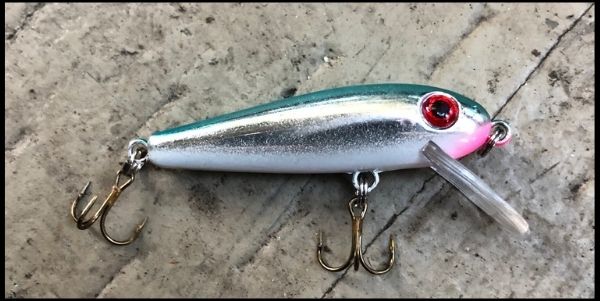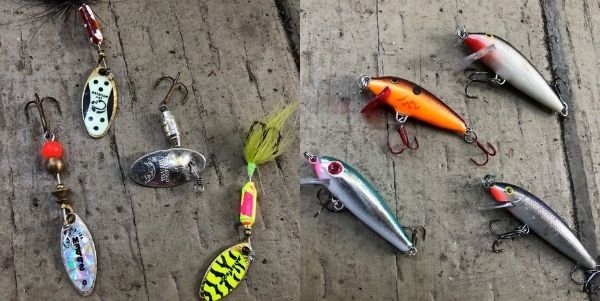Last updated on February 14th, 2024 at 01:44 pm
Last updated on February 14th, 2024
Winter can be challenging for anglers. Lakes and streams may appear void of any trout. Meanwhile, you stand onshore suffering the cold, making cast after cast with no results. Sound familiar?
It’s a hurdle all diehard anglers have to face. But, you can still catch trout. You can! And the go-to solution for many is ultralight fishing. Downsizing your presentation could mean the difference between frostbite misery and landing some fish. So, consider the following ultralight lures for your next frosty adventure, they’re deadly when that temperature drops.
But first,
Why Fish Ultralight Lures?
Well, fish slow down quite a bit in winter, causing them to eat less. Of course, this varies across the country as regional climates shift differently. But in general, trout will migrate to deeper water where they feel safe. In response to a lack of insects and larva, baitfish, and crawfish, their metabolisms slow to where they require less food. Pretty ingenious, eh?
This is why using a smaller presentation can be so effective and why many anglers choose ultralight lures as their weapon of choice in winter. A smaller presentation means less chance of a meal escaping to a trout.
1.) Ultralight Fishing: Marabou Jigs
Oh, the magic of Marabou feathers! There’s nothing else out there that produces the same presentation; a subtle wave and flow that entices slower, winter trout. They’re especially lethal when fished in moving water. I like to cast upstream ( always upstream) and let the jig drift naturally with the current.
As the jig ticks the bottom, gently raise your rod tip pop the jig off the bottom, and repeat this pattern until the jig sweeps across the stream and heads back to you. In lakes, you can fish a Marabou Jig under a bobber by raising your rod tip creating that tasty wave of feathers. Repeat this cadence back to shore. As a minnow imitation, these jigs are a staple for trout anglers in winter for their finesse profile and action, and they’re perfect on light tackle.

Selecting a Jig
When selecting the color of your Jig, go with natural colors and work your way toward the dark. Natural colors would include dark greens, olive, and brown. A standard size to fit most scenarios is a 1/16th oz jig. If water conditions are high and rough, you can size up to a 1/8 oz.
2.) Rapala Ultra Light Minnow
The Rapala ultralight minnow is a shallow diving lure that works perfectly in cold weather scenarios. This lure is slow-sinking, which means you can fish your desired depth, and its weighted body also casts long distances. Just cast out and begin counting – the lure sinks 1ft per second. The size of this bait is perfect for those sluggish fish, especially in river systems where trout are accustomed to seeing smaller prey like insects and worms.
In colder water, try giving this lure a twitch and pause retrieve. Follow that up with a straight retrieve but keep it moving slowly. Trout are easily turned off by the slightest peculiarity, and a minnow swimming too fast in winter not only doesn’t look right, but also presents a meal too difficult to chase down.
Selecting Minnows
Try making your selection based on the water you’ll be fishing. Research what baitfish are present and what other anglers are using. Generally, you can’t go wrong with:
- 2 1/2″ Rainbow Trout
- 2 1/2″ Brown Trout
- 2.5 ” Chrome Minnow
Natural colors are the most effective. For example, if you’re fishing for Rainbow Trout, then it’s best to match the hatch with a Rainbow Trout color. Begin with natural colors and work your way toward brighter colors when water clarity is stained.
3.) Ultralight Fishing: Micro Worms
Microworms are a perfect lure for when nightcrawlers aren’t available. Using an ultra-light bobber setup, you can drift your worm along undercut banks, brush piles, boulders, etc. If you’re certain the fish on your stream or lake have transitioned to winter, then try finding those deep pockets. For example, on rivers, a long tail out that leads to a deep, slow-moving pool is a perfect place for trout to rest during winter.
Another reason I like fishing microworms or any bobber setup is that you place your presentation right in front of the fish. Often in winter, trout will avoid chasing down prey, especially in moving water, thus using up calories, and potentially losing a meal. But a slow-moving entre brought right to their mouth is a different story!
Selecting Micro worms
Most often, colors ranging from pink to more natural colors like dark green and brown are perfect for creeks and rivers. Using a 1/16 oz jig head, thread the worm down the shank of the hook until it appears even on the hook ( the worm shouldn’t be bunched up on the hook). For jig head colors, white or black tend to match the water conditions well.
4.) Leech Fly Patterns
Commonly found in waters across the country, leeches are a natural part of a trout’s diet. What’s more, it’s perfect for when conditions are tough. Like microworms, you can use an ultralight bobber set up with a braided line to a 2-6 lb fluorocarbon leader and drift it along slow-moving water in creeks and rivers. If you’re fishing smaller water, try starting at the bottom of the run and work your way back up to avoid spooking any fish.
Secure a split-shot weight ( or two) if the current is moving along quickly to get your leech into the optimal strike zone. If you see fish feeding on the bottom, try using a split shot to weigh your leech down.
Selecting a Leech
Effective leech patterns include black, brown, and grey/ white. Brands that many anglers tend to rely on in winter include:
- Bunny Leeches
- Cheech Leeches
- Pine Squirrel Leech
5.) Ultralight Fishing: Spinners
Spinners like Mepps and Panther Martins are the tried and true. Few lures on the market are as versatile and effective as baitfish imitators as these metal killers. And even though trout are sluggish, they still eat baitfish in winter. When fishing a spinner, cast upstream and retrieve your lure down with the current. Reel fast to keep the blades moving and flashing. Spinners are most effective in lower light scenarios, early morning, and early evening. Or, you can target shaded areas.
And, as always, fish in slower water. Currents near boulders and logs are perfect resting places for trout in winter, so try retrieving your spinner alongside cover like this where the current slows. Some great spinner brands to try:
- Mepps Aglia Light Spinner 1/18th oz.
- Panther Martin
- Wordens Rooster Tail 1/16th oz
Ultralight Fishing: Selecting Spinners
It’s best to select a spinner that matches the baitfish in your waters. Some good starters are Rainbow Trout patterns and Brown Trout patterns with silver blades.
Final thoughts
All in all, these ultralight lures are pretty effective in winter when thrown on light tackle. Having the correct presentation will provide you with a more comfortable winter fishing experience. Start with the lures above and experiment with others to find that perfect set you feel confident with. The most effective strategy this time of year is keeping your presentation small and slow-moving.





